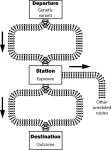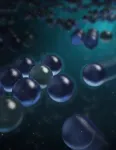(Press-News.org) The most recent COVID-19 booster shot reduces adults’ risk of moderate or severe COVID by more than half, according to a new nationwide data study from September 2023 through January 2024, a period of JN.1 variant dominance.
The new study is one of the first to evaluate protection provided by the updated shot against COVID-19-associated emergency department and urgent care visits (markers for moderate disease) and against hospitalizations (a marker for severe disease), in individuals 18 and older, due to JN.1, the most recently predominant strain of COVID.
“Halving your risk of needing to visit an E.D. or urgent care center or to be treated in the hospital for COVID is significant,” said study co-author Shaun Grannis, M.D., M.S., Regenstrief Institute vice president for data and analytics and a professor at Indiana University School of Medicine. “As an informatician I want to highlight that the data we analyzed came from different populations and geographic locations, adults of all ages and the most recent COVID strain. This analysis strongly supports the benefit of getting a booster shot and as a clinician, I encourage my patients to do so.”
“These are encouraging findings,” said study co-author Brian Dixon, PhD, MPA, interim director of Regenstrief Institute’s Clem McDonald Center for Biomedical Informatics and professor at Indiana University Richard M. Fairbanks School of Public Health. “These estimates of vaccine effectiveness are what we would expect for an annual booster designed for an endemic virus that continues to evolve. We looked at a longer time period than similar studies in Europe, and we found good performance. Yet we do need to be alert to the presumed waning of the updated booster’s effectiveness, which we have seen in earlier COVID-19 vaccines. Americans should expect the CDC to recommend future boosters, likely on an annual schedule.”
These findings of protection against moderate and severe disease provided by the booster in this large study are consistent with those of an earlier, small scale study of individuals seen for testing at a pharmacy. That study did not include hospitalized patients.
The authors of the new study, co-authored by Drs. Grannis and Dixon, concluded, “In this analysis of updated COVID-19 VE [vaccine effectiveness], receipt of an updated COVID-19 vaccine dose provided protection against COVID-19-associated ED/UC [emergency department/critical care] visits and hospitalizations among immunocompetent adults. CDC will continue monitoring VE of updated COVID-19 vaccines. All adults should stay up to date with recommended COVID-19 vaccines, including receiving a dose of updated vaccine.”
“Interim Effectiveness of Updated 2023–2024 (Monovalent XBB.1.5) COVID-19 Vaccines Against COVID-19–Associated Emergency Department and Urgent Care Encounters and Hospitalization Among Immunocompetent Adults Aged ≥18 Years — VISION and IVY Networks, September 2023–January 2024” is published in Morbidity and Mortality Report (MMWR). The study was funded by the CDC.
All authors and affiliations
Jennifer DeCuir, MD, PhD1; Amanda B. Payne, PhD1; Wesley H. Self, MD2; Elizabeth A.K. Rowley, DrPH3; Kristin Dascomb, MD, PhD4; Malini B. DeSilva, MD5; Stephanie A. Irving, MHS6; Shaun J. Grannis, MD7,8; Toan C. Ong, PhD9; Nicola P. Klein, MD, PhD10; Zachary A. Weber, PhD3; Sarah E. Reese, PhD3; Sarah W. Ball, ScD3; Michelle A. Barron9; Allison L. Naleway, PhD6; Brian E. Dixon, PhD8,39; Inih Essien, OD5; Daniel Bride, MS4; Karthik Natarajan, PhD11,12; Bruce Fireman10; Ami B. Shah, MPH1,13; Erica Okwuazi, MSc1,13; Ryan Wiegand, PhD1; Yuwei Zhu, MD2; Adam S. Lauring, MD, PhD14; Emily T. Martin, PhD14; Manjusha Gaglani, MBBS15,16; Ithan D. Peltan, MD17,18; Samuel M. Brown, MD17,18; Adit A. Ginde, MD9; Nicholas M. Mohr, MD19; Kevin W. Gibbs, MD20; David N. Hager, MD, PhD21; Matthew Prekker, MD22; Amira Mohamed, MD23; Vasisht Srinivasan, MD24; Jay S. Steingrub, MD25; Akram Khan, MD26; Laurence W. Busse, MD27; Abhijit Duggal, MD28; Jennifer G. Wilson, MD29; Steven Y. Chang, MD, PhD30; Christopher Mallow, MD31; Jennie H. Kwon, DO32; Matthew C. Exline, MD33; Cristie Columbus, MD15,34; Ivana A. Vaughn, PhD35; Basmah Safdar, MD36; Jarrod M. Mosier, MD37; Estelle S. Harris, MD18; Jonathan D. Casey, MD2; James D. Chappell, MD, PhD2; Carlos G. Grijalva, MD2; Sydney A. Swan2; Cassandra Johnson, MS2; Nathaniel M. Lewis, PhD38; Sascha Ellington, PhD38; Katherine Adams, MPH38; Mark W. Tenforde, MD, PhD38; Clinton R. Paden, PhD1; Fatimah S. Dawood, MD1; Katherine E. Fleming-Dutra, MD1; Diya Surie, MD1; Ruth Link-Gelles, PhD1; CDC COVID-19 Vaccine Effectiveness Collaborators
1Coronavirus and Other Respiratory Viruses Division, National Center for Immunization and Respiratory Diseases, CDC; 2Vanderbilt University Medical Center, Nashville, Tennessee; 3Westat, Rockville, Maryland; 4Division of Infectious Diseases and Clinical Epidemiology, Intermountain Healthcare, Salt Lake City, Utah; 5HealthPartners Institute, Minneapolis, Minnesota; 6Kaiser Permanente Center for Health Research, Portland, Oregon; 7Indiana University School of Medicine, Indianapolis, Indiana; 8Regenstrief Institute Center for Biomedical Informatics, Indianapolis, Indiana; 9University of Colorado School of Medicine, Aurora, Colorado; 10Kaiser Permanente Vaccine Study Center, Kaiser Permanente Northern California Division of Research, Oakland, California; 11Department of Biomedical Informatics, Columbia University Irving Medical Center, New York, New York; 12New York-Presbyterian Hospital, New York, New York; 13General Dynamics Information Technology, Falls Church, Virginia; 14University of Michigan, Ann Arbor, Michigan; 15Baylor Scott & White Health, Texas; 16Baylor College of Medicine, Temple, Texas; 17Intermountain Medical Center, Murray, Utah; 18University of Utah, Salt Lake City, Utah; 19University of Iowa, Iowa City, Iowa; 20Wake Forest School of Medicine, Winston-Salem, North Carolina; 21Johns Hopkins University School of Medicine, Baltimore, Maryland; 22Hennepin County Medical Center, Minneapolis, Minnesota; 23Montefiore Medical Center, Albert Einstein College of Medicine, New York, New York; 24University of Washington, Seattle, Washington; 25Baystate Medical Center, Springfield, Massachusetts; 26Oregon Health & Science University, Portland, Oregon; 27Emory University, Atlanta, Georgia; 28Cleveland Clinic, Cleveland, Ohio; 29Stanford University School of Medicine, Stanford, California; 30Ronald Reagan UCLA Medical Center, Los Angeles, California; 31University of Miami, Miami, Florida; 32Washington University in St. Louis, St. Louis, Missouri; 33The Ohio State University, Columbus, Ohio; 34Texas A&M University College of Medicine, Dallas, Texas; 35Henry Ford Health, Detroit, Michigan; 36Yale University School of Medicine, New Haven, Connecticut; 37University of Arizona, Tucson, Arizona; 38Influenza Division, National Center for Immunization and Respiratory Diseases, CDC; 39Richard M. Fairbanks School of Public Health at Indiana University-Indianapolis
About Shaun Grannis, M.D., M.S.
In addition to his role as the vice president for data and analytics at Regenstrief Institute, Shaun Grannis, M.D., M.S., holds the Regenstrief Chair in Medical Informatics and is a professor of family medicine at Indiana University School of Medicine.
Brian E. Dixon, PhD, MPA
In addition to his role as the director of public health informatics at Regenstrief Institute and Indiana University Richard M. Fairbanks School of Public Health at Indiana University-Indianapolis, Brian E. Dixon, PhD, MPA, is the interim director and a research scientist with the Clem McDonald Center for Biomedical Informatics at Regenstrief Institute and an associate professor of epidemiology at Indiana University Fairbanks School of Public Health at IUPUI. He is also an affiliate scientist at the U.S. Department of Veterans Affairs Health Services Research and Development Center for Health Information and Communication, Richard L. Roudebush VA Medical Center.
END
Latest booster reduces adults’ risk of moderate or severe COVID by more than half
2024-03-01
ELSE PRESS RELEASES FROM THIS DATE:
Making sense of Mendelian randomization
2024-03-01
Mendelian randomization, a powerful tool in medical research, helps us understand whether certain factors truly cause disease. This technique uses genetic variations as "natural experiments" to reveal cause-and-effect relationships. However, choosing the proper genetic variations is crucial for accurate results.
Think of a train network where the genetic variation is the starting point, the exposure is a station, and the disease is the destination. The train must pass through the exposure station en route to the disease. This represents the critical assumption of Mendelian randomization: ...
Precision pulmonary medicine: Penn engineers target lung disease with lipid nanoparticles
2024-03-01
Penn Engineers have developed a new means of targeting the lungs with lipid nanoparticles (LNPs), the miniscule capsules used by the Moderna and Pfizer-BioNTech COVID-19 vaccines to deliver mRNA, opening the door to novel treatments for pulmonary diseases like cystic fibrosis.
In a paper in Nature Communications, Michael J. Mitchell, Associate Professor in the Department of Bioengineering, demonstrates a new method for efficiently determining which LNPs are likely to bind to the lungs, rather than the liver. “The way the liver is designed,” says Mitchell, “LNPs tend to filter into hepatic cells, and struggle ...
Scientists make nanoparticles dance to unravel quantum limits
2024-03-01
The question of where the boundary between classical and quantum physics lies is one of the longest-standing pursuits of modern scientific research and in new research published today, scientists demonstrate a novel platform that could help us find an answer.
The laws of quantum physics govern the behaviour of particles at miniscule scales, leading to phenomena such as quantum entanglement, where the properties of entangled particles become inextricably linked in ways that cannot be explained by classical physics.
Research in quantum physics ...
Study identifies multi-organ response to seven days without food
2024-03-01
New findings reveal that the body undergoes significant, systematic changes across multiple organs during prolonged periods of fasting. The results demonstrate evidence of health benefits beyond weight loss, but also show that any potentially health-altering changes appear to occur only after three days without food.
The study, published today in Nature Metabolism, advances our understanding of what’s happening across the body after prolonged periods without food.
By identifying the potential health benefits from fasting ...
New microbiome insights could help boost immunotherapy for a range of rare cancers
2024-03-01
The microbiome can identify those who benefit from combination immunotherapy across multiple different cancers, including rare gynaecological cancers, biliary tract cancers and melanoma.
Researchers from the Wellcome Sanger Institute, the Olivia Newton-John Cancer Research Institute in Australia, and collaborators, have identified specific strains of bacteria that are linked with a positive response to combination immunotherapy in the largest study of its kind.
The study, published today (1 March) in Nature Medicine, details a signature collection of microorganisms in an individual’s gut bacteria that may help identify those who would benefit from combination immunotherapy and ...
It’s not only opposites that attract – new study shows like-charged particles can come together
2024-03-01
A study published today in Nature Nanotechnology shows that similarly charged particles can sometimes attract, rather than repel.
The team found that like-charged particles suspended in liquids can attract one another at long-range, depending on the solvent and the sign of the charge.
The study has immediate implications for processes that involve interactions in solution across various length-scales, including self-assembly, crystallisation, and phase separation.
‘Opposites charges attract; like charges repel’ is a fundamental principle of basic physics. But a new study from Oxford University, published today in Nature Nanotechnology, has demonstrated that similarly ...
Japanese wolves are most closely related to dogs and share DNA with East Eurasian dogs
2024-03-01
In this study, we determined nine genomes of Japanese wolves and 11 genomes of modern Japanese dogs at high coverage and analyzed with one hundred dog and wolf genomes in the public database. The analyses showed that 1) the Japanese wolf was a unique subspecies of the gray wolf that is genetically distinct from both extant and ancient gray wolves known to date, 2) the Japanese wolf is most closely related to the monophyletic group of dogs. Furthermore, 3) Japanese wolf ancestry has introgressed into the ancestor of East Eurasian dogs at an early stage of the dog’s history ...
Brown bears digging up artificial forests
2024-03-01
Brown bears foraging for food in the Shiretoko Peninsula of Hokkaido, Japan, have been disrupting tree growth in artificial conifer forests, according to a new study. Researchers compared soil and tree samples from human-forested plots with samples from natural forests. They found that the bears’ digging for cicada nymphs damaged tree roots and altered the nitrogen content of the soil, which in turn limited the diameter growth of trees. The phenomena of bears digging for cicadas, an unusual food source, appears to be restricted to human-planted conifer forest; diversely vegetated natural forest ...
Innovative domain-adaptive method enables 3D face reconstruction from single depth images
2024-03-01
Reconstructing a 3D face from visuals is crucial for digital face modeling and manipulation. Traditional methods predominantly depend on RGB images, which are susceptible to lighting variations and offer only 2D information. In contrast, depth images, resistant to lighting changes, directly capture 3D data, offering a potential solution for robust reconstructions. Recent studies have turned to deep learning for more robust reconstruction from depth data; however, the scarcity of real depth images with accurate 3D facial labels has hindered the training process. Attempts to use auto-synthesized data for training have met limitations ...
Groundbreaking study unveils unique roles of yeast protein complexes in cellular lifespan and environmental response by rationally engineering based on the predicted three-dimensional structures
2024-03-01
Assistant Professor Takahiro Kosugi of Institute for Molecular Science, assistant Professor Yoshiaki Kamada at National Institute for Basic Biology, and colleagues have developed an advanced molecular cell biology approach by integrating computational redesigning of protein complexes based on the predicted three-dimensional structure into yeast genetics. They revealed that two types of protein complexes in yeast, which were thought to have the same function, play distinct roles in cellular environmental response and lifespan. Furthermore, ...







